► Ineos Grenadier vs its 4×4 rivals
► Comparison with Defender and Ranger
► Who makes Britain’s toughest 4×4?
The Ineos Grenadier is the modern-day equivalent of the Land Rover Defender: billionaire Jim Ratcliffe’s ode to a tougher, rougher kind of 4×4 that’ll cross a Scottish moor one day and drive into Edinburgh city centre the next. But is it any good? To find out, CAR magazine assembled Land Rover’s own reimagined Defender and a no-frills Ford Ranger pick-up to provide context. Read on for detailed comparison group test.
Ineos Grenadier: the briefing
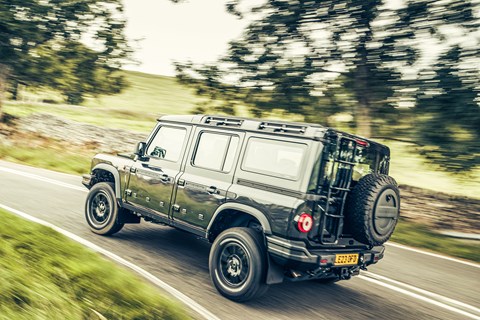
Why is it here?
It’s the age-old story. Boy loves the old Land Rover Defender. Land Rover kills the old Defender. Boy starts car company to build his own…. Created to be everything the new Defender is not (mechanical, utilitarian, focused on off-road ability to the detriment of its road manners), Sir Jim Ratcliffe’s Grenadier is a set-square-edged labour of love.
Any clever stuff?
Yes, but it’s all proven 4×4 stuff; rugged ladder frame, three locking diffs, modest 17-inch wheels wearing fat all-terrain rubber, beam axles front and rear with masses of articulation, a transfer case for low-and high-range drive and heavy-duty coil-sprung suspension. It’s built tough but you still get lovely leather Recaros, an infotainment screen and, crucially, a compass with altimeter.
Which version is this?
There are four body styles: the commercial-certified two-seat and five-seat Utility Wagons, the recently revealed Quartermaster pick-up and the version we have here, the five-seat passenger Station Wagon. There are two Belstaff special editions. Ours, the Trialmaster, from £76k, bundles in a load of must-have off-road gear including the locking diffs, BFGoodrich tyres on 17-inch steel wheels and the compass.
Land Rover Defender: the briefing
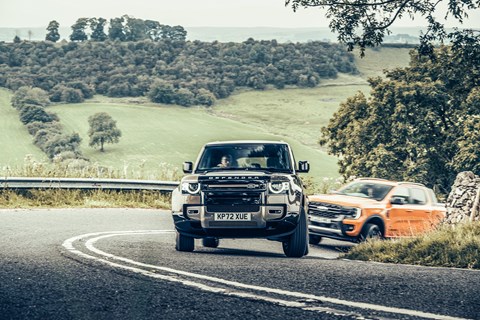
Why is it here?
Because Land Rover wouldn’t exist without the Defender bloodline – and neither would the Grenadier. Unveiled in 2019 after years of concepts and false starts, today’s Land Rover Defender is a triumph: a desirable, stylish reboot that eclipses its predecessor on the rough and, on road, shows it such a clean pair of heels you could eat your dinner off them.
Any clever stuff?
That remarkable bandwidth is the result of a bewildering tech arsenal, which runs to just about everything except rear-wheel steering (just adopted on the latest Range Rover and Range Rover Sport). There’s intelligent four-wheel drive, an e-diff with torque vectoring, air-sprung (see image) independent suspension, a two-speed transfer case, Terrain Response 2 with traction control and Hill Descent Control… Oh, and a gorgeous turbocharged three-litre straight-six that’ll have you purring like the Elmlea factory cat.
Which version is this?
The middling 110 in chic X trim. It chimes in at a fulsome £91,185 (the Range Rover Sport starts at £83k…) with only modest options (tinted privacy glass, three-zone climate control with air purification plus, onboard wi-fi and a security tracker, for £1500).
Ford Ranger Wildtrack: the briefing
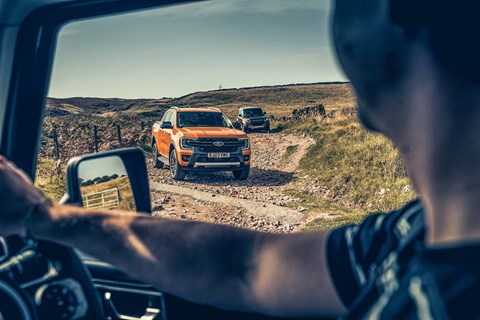
Why is it here?
As a cut-price curveball, to prove how far pick-up trucks have come and why, if you need family transport with some off-road ability, you don’t have to spend the thick end of £100,000. The Ford Ranger, er, range kicks off at a refreshingly palatable £28k (excluding VAT), while the double cab starts at £30k (ditto). The V6 diesel is essential if you’re to have any chance against the well-endowed Land Rover and Ineos, and when you go for that you’re instantly into Wildtrack territory.
Any clever stuff?
The really clever bit is that, despite a leaf-sprung rear end, the Ranger drives well on the road.
Which version is this?
A Wildtrack in must-have Cyber Orange (£500) and wearing the lightest smattering of cost options. In the mix are the all but essential £450 audio upgrade, the £1600 power roller shutter for the loadbed and the £1100 Technology Package. All-in, with VAT, you’re looking at £58k. The nutty, near-300bhp Raptor is also an option but we wanted to keep things vaguely practical, plus the Raptor’s suspension – while sublime – means it loses a whole load of carrying capacity and its VAT-dodging commercial classification.
Ineos Grenadier vs Land Rover Defender vs Ford Ranger Wildtrack: the test
Absolute objectivity. A spotless critical faculty unsullied by preconceptions. Walls of the mind, sky-high and solidly built, against which bias splatters like so much rotten fruit. This is the Zen-like state in which CAR’s crack (I said ‘crack’) team begins each and every test. Ruthlessly cultivated with ice baths, weeks of lonely meditation high on Fenland mountainsides and long walks in wildernesses without wi-fi, it is the way. We owe it to the cars. We owe it to ourselves. We owe it to you.
Except that we’re into cars, so that’s not quite how it works. Instead, like a cow’s hard-working stomachs, our minds have likely already absorbed hundreds of hours of press material, previous content and off-the-record discussions before we get anywhere near the machines in question.
How we test cars: CAR magazine’s road testing protocols
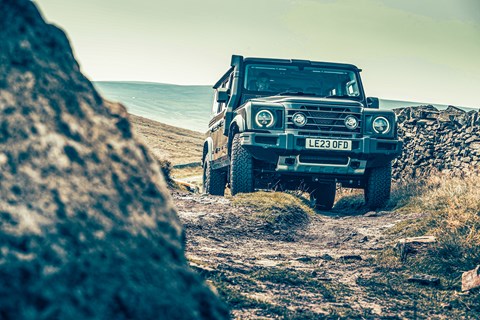
And so, ahead of this contest, I’ve decided the Grenadier will drive like an old Defender, making it of minimal interest to anyone without a rural veterinary business. The Ranger pick-up will put up a good fight before falling back, hamstrung by the lack of luxury conferred by its price point and humble leaf-sprung underpinnings. And the Defender will, with a couple of mostly price-related caveats, romp to victory. Simple.
Except that as we get into it, thundering along sun-scorched roads and lurching into the rocky, unkempt and firmly tarmac-free heart of the Peak District, the original hypothesis starts merrily springing leaks like an MoT-fail submarine. The Ranger plain refuses to drop out of contention, over-performing like a Haas podium lock-out, and the Grenadier turns out to be one of the most charismatic cars we’ve driven all year. Time for that ice bath…
Small, lightweight, compact. Columnist Gavin Green is a forceful proponent of the idea that less is more, regularly espousing the virtues of keeping things simple from his 700-word pulpit. And as enthusiasts we know his word to be true. But like keto dieters presented with a crusty white farmhouse loaf, still oven-warm, show us a vast primary-coloured pick-up truck, its edges chiselled like David Gandy’s cheekbones, and we’re powerless to resist. Jeez, the Ford looks great in Wildtrack trim, its (£600 excluding VAT) Cyber Orange paint glowing in the pre-dawn half-light.
It’s early when I climb up into the Ranger (love those A-pillar grab handles) but the air’s already warm like an Iberian swimming pool, these being the dog days of the September heatwave. I want to crank the seat high, the better to see the truck’s distant corners, but it’s front-hinged so raising it also tilts it forward uncomfortably. The vaguely retro interior feels several orders of magnitude less special than the Grenadier’s and less expensive than the Defender’s. Whatever. It’s a nice place to be, its Mustang-inspired cliff face of a dashboard riven with mesh and the contrast yellow stitching doing a great job of offsetting the endless black plastic. Phone connectivity is slick, the driver’s display is easy to understand and the big portrait touchscreen just the acceptable side of fiddly.
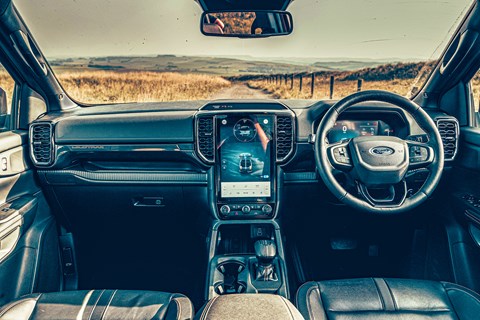
The adaptive cruise is painful, inexplicably slowing for anything and everything (normal cruise is also an option, fortunately), and there’s no audible prompt to confirm you’ve found reverse, so you’re endlessly checking the driver’s display during five-point turns. But, unlike the aircraft carrier-sized F-150 I drove a couple of years ago, the steering wheel is of a faintly normal diameter; small, even. Turns out this is a clue.
The Ford defies expectation time and again as we cut through the morning mist. These roads flatter it, sure, being mostly smooth and flowing. It’s also dry, which helps when you’ve a leaf-sprung rear axle and no weight in the loadbay bar a laptop and an apple in a bag.
But where I expect sluggish performance, messy oversteer and indifferent steering, the Wildtrack responds with a cohesive driving experience that actually betters the Defender for body control and runs it close on steering. There’s an easy grace to the way the Ford bowls along, its fragile ride becoming less of an issue as you gather speed (rough urban roads are its nemesis). The steering is natural in feel, fairly direct and, though its limits are low, they’re well telegraphed.
We have the flagship engine, the 237bhp V6 diesel. It drives one or both axles (your call – select two- or four-wheel drive, plus high or low range) via a 10-speed auto. And if it never feels truly fast, neither is it slow: 8.7sec 0-62mph isn’t tardy and there’s easy urge (and close to the official 28mpg) all day long. Yes, the effort the powertrain is clearly making and the rate with which you gather speed feel entirely out of sync, like the road’s flooded with treacle, but remember the Ford is both huge and, at 2519kg, heavy in a way that’d make Gavin sad.
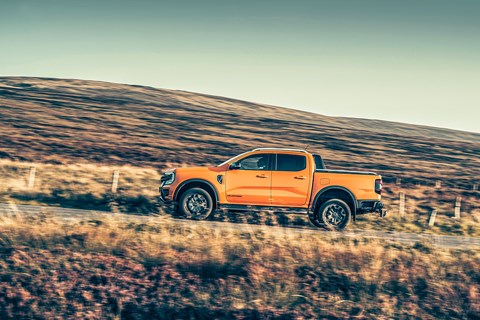
Then we hit the Peaks, and suddenly the Ranger’s a little less happy. Washboard corners give the rear axle a hard time. It tramps out of tight turns, goes through phases of barely damped oscillation and gets really untidy should you find yourself inexplicably deactivating the stability control (sorry everyone – won’t happen again). The lack of full-time four-wheel drive, while undoubtedly sensible, can catch you out even on dew-damp grass, too. At least engaging both axles is as quick and as easy as turning on the radio.
This must be the spot. Our OS map, helpfully marked up by a local green guru, has brought us to an ancient rocky track leading off up the hillside – a boulder-floored tunnel of green, steep and barely wide enough for a Caterham.
You can almost see the glee on the Grenadier’s face, like a kid with an ice cream sundae the size of the FA Cup. The Defender, cool and assured, looks almost offended that we can’t find anything tougher. And the Ranger? CAR’s Tom Wiltshire and I briefly discuss leaving it behind.
‘The Ranger’s impressive on the road but then so was its predecessor,’ says Tom between glugs of water. ‘It drives so well, and I love the beefy diesel engine and refined 10-speed gearbox. Off-road, though? I’m worried it’s too long and doesn’t have the ground clearance.’ (Ford will happily sell you a Ranger Raptor if you love dirty weekends in the rough stuff.)
Colin Overland, who’s in the Ford, is quietly confident. ‘Let’s see how we go.’
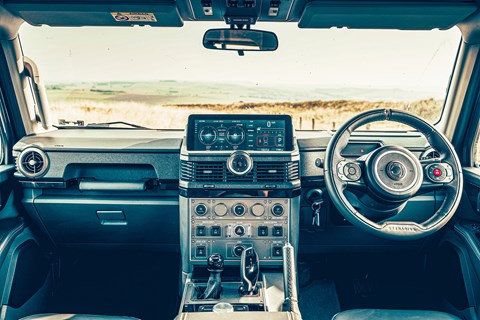
I hop into the Grenadier, figuring our most overtly off-road car should probably go first. If it has but a shred of substance to back up the style, the Ineos should be unstoppable. Broad, bluff, Brutalist and with an aesthetic that’s at once familiar but kind of mind-warping, like someone hit an AI illustration tool with the name of every utilitarian 4×4 you could think of, from old Defender to original military Humvee, the Grenadier looks more siege of Basra than Buxton byway.
The Grenadier feels right the moment you climb in and slam your door shut (not slamming isn’t an option – only if the act of closing them can be heard in the next county does the car consider the job done). It takes all that was right about the old Defender but adds size for increased interior space (there’s somewhere for your right arm, for instance) and a load of proven good stuff from respected sources. Yes, this is an Ineos. But the great seats are Recaro and the fantastic powertrain (petrol in this instance, though diesel power is a slightly less good option) from BMW, the gearbox a faultless ZF.
Onto these sound fundamentals the Ineos then layers a load of its own character: an almost entirely absent driver’s display ahead of you (everything you need is on the main central screen instead, with the speedo prominent in the top-right corner); the miliary-jet chic of a control panel above your head; charming safari windows.
The Grenadier and I roar forwards on a wave of silken straight-six power. As we head uphill, things go downhill. The surface, initially rock-strewn but easily driven, gets lumpier and bumpier until the BFGoodriches are crawling over lumps of masonry the size of microwaves. At the same time the green walls move in on us like Vader’s trash compactor. Soon hoary old thorn bushes and trees are screeching their way down our painted flanks like nails on a blackboard…
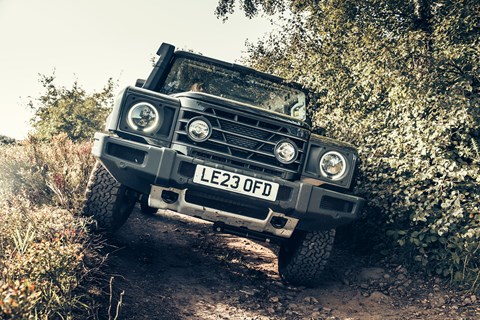
At the wheel, working to maintain some momentum while also picking a line where I can, I should be a mess. But the Grenadier is entirely untroubled, its towering off-road ability barely tested. We’ve so much more capability up our sleeve, from locking diffs and a low-range ’box to a winch if we really come a cropper. But the Grenadier needs none of it, as happy here as a 911 GT3 RS on the fast curves of Suzuka.
The track refuses to get any easier, throwing big washouts and fallen trees our way, together with an equally steep descent back to civilisation. All three cars pass untroubled, Ranger included, and in the next valley the going opens up into a graded stretch of gravel running around a lunar-looking quarry. Gunning the Grenadier, its imperious suspension and bank-vault sense of structural integrity shrug off every lump, bump and pothole. Australia’s scorched interior, Morocco’s barren south, the endless trails of California – the Ineos has you yearning to drive them all.
Too soon we hit tarmac again. Turning 90° onto the road, I naively combine a couple of turns of steering lock with an ill-advised boot of throttle. Sound as the recirculating-ball set-up’s just proved on the trails, robust and impervious to shocks, on the road it clearly skipped finishing school.
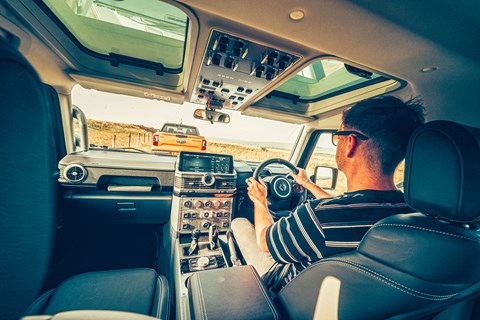
Its sloth-like ratio and profound lack of self-centering combine to see me pinball off up the road, merrily wrestling the wheel this way and that as I battle to regain something like a consistent heading. With seat time you learn its foibles, of course. But, gone soft as most of us have on steering that’s direct, easy, linear, self-centering, accurate, responsive (the turning circle’s a ponderous 13.5m) and occasionally even tactile, the Grenadier’s is discombobulating.
By contrast, the living on planet Defender is easy. Land Rover’s refusal to cede an ounce of off-road ability may be head-scratching at times (weight, complexity, CO2 emissions, price and thirst would all benefit) but it has at least created some admirably capable cars; cars with delightful road manners and the go-anywhere chops to explore the moon, were the shipping costs less prohibitive.
It has its critics but everyone I know wants a Defender. Everyone. Rugged yet luxurious feels vaguely oxymoronic but the desirable Land Rover makes the idea sing, its carefully cultivated utilitarian vibe adding a veneer of social acceptability to what is a very expensive, very luxurious car.
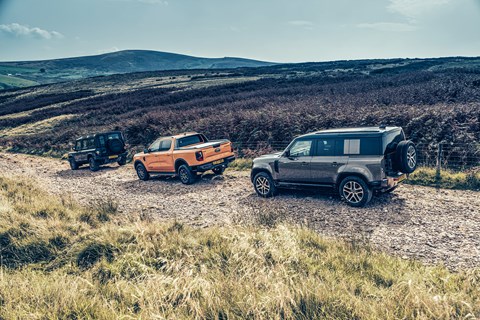
It looks a million dollars on the outside. But if anything the inside is even better; good looking and with the storage to swallow the entire stock of a modest Tesco Express. The door cards are studded with chunky bolt heads, the rail on the dash silently speaks of bouncing your way across Namibia and the material selection is faultless. Some of the rough moulded plastics would feel like interlopers in a Range Rover, but here they’re bang on, as are the digital instruments with their brushed metal look and the nicely blocky Duplo-spec buttons.
The unyielding, bolt-upright seats shouldn’t work but they’re all-day comfortable and the commanding driving position so right you could do hundreds of miles in a day in this thing stress-free. That said, the seats offer zero lateral support, which is a pretty good clue as to the ride/handling balance.
The steering’s okay: nothing more, nothing less. It’s nicely weighted and accurate, helping you place what is a massive car without effort, but it’s neither as quick nor as tactile as you expect. The brake pedal too is relatively inert, with a lot of initial travel. Almost like the car’s trying to tune you onto its wavelength…
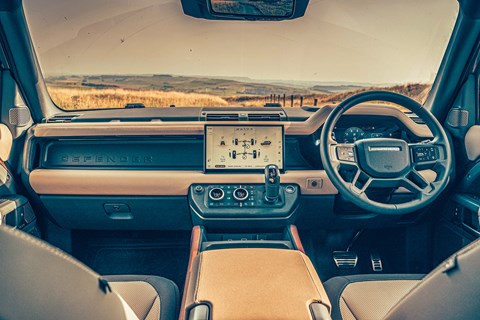
Do so and progress is effortless, the world sliding by the windows like a slow-scrolling Constable as Radio 4 drops your heart rate and the Land Rover’s crushing rolling refinement teases the tension from your scrunched-up shoulder blades. Through long corners tackled with too much enthusiasm there’s pronounced bodyroll, of course. And like the Ford the Defender’s engine is always working hard to gather speed. But the mild-hybrid six sounds gorgeous, feels serene at 70mph (just 1500rpm in top) and works with the nicely judged ride to create a very likeable, hugely relaxing road car.
And off-road? So talented it almost takes the fun out of it. Tom: ‘The Defender’s so capable on the rough stuff I can’t imagine what kind of a place you need to go to really challenge it. But the experience is hardly analogue or involving – the car’s doing so much of the work you that you feel superfluous, which likely makes it the best option for people either inexperienced or simply uninterested in the nuances of off-road driving.’
Whereas, of course, ‘analogue’ and ‘involving’ are the Grenadier’s middle names…
Ineos Grenadier vs Land Rover Defender vs Ford Ranger Wildtrack: the verdict
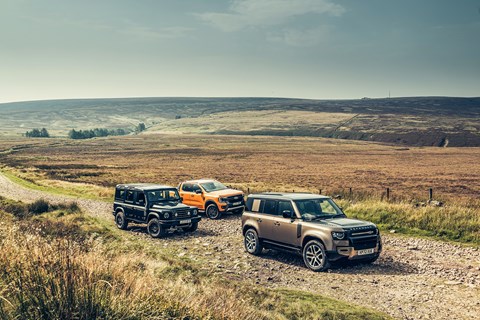
Darkness has fallen but the embers of a fiery sunset burn in the western sky behind me. It’s been a long, sticky day. Caked in dust, its wheelwells thick with mud and flanks lightly branch-scarred, the Grenadier looks fantastic.
Heading home, I’m having a bit of a moment in the Ineos. Spaced out on fatigue, it’s all gone a bit trippy. There’s something hypnotic about this drive; the safari windows popped open, the thrum of the all-terrain tyres on the road, the dash’s combined altimeter and compass comfortingly confirming our rapid and relentless progress both east and closer to sea level…
The Grenadier oozes charisma like a Glade plug-in oozes Bamboo & Waterlily Bliss. With its BMW six it’s as fast as you could ever want, cruising at 85mph where conditions permit and gunning past long lines of dawdlers on sinuous rural A-roads. Get into the groove, learn to tease it through corners smoothly to avoid interference from the paranoid stability control and it’s a fun if oddball road car. Spacious, ruggedly handsome and with a feelgood factor at odds with its utilitarian brief, it elevates the everyday with its chunky charm.
The Grenadier was created to fill the negative space around the Defender; to be everything the Land Rover is not. Given the Defender’s broad and obvious appeal, that logically renders the Ineos a niche proposition. The actual Defender is, unsurprisingly perhaps, the better car. But if – as our letters pages would suggest many of you are – you’re craving something less polished, more characterful and grittier than your typical 2024 new car, then the Grenadier is not to be overlooked. Like a VW camper it’s the kind of machine kids, young and old, will adore; the kind of car you’ll plan holidays around and make memories in. Just be sure to get a test drive – for many the steering alone will be a deal-breaker.
And the Ranger? Great to drive, easy to live with, family-ready and tough enough for most, the Ford shows the other two up as almost embarrassingly expensive. It’ll likely prove painless to own, too. But it also lacks the charm of the Defender, let alone the Grenadier, if not much of their actual capability.
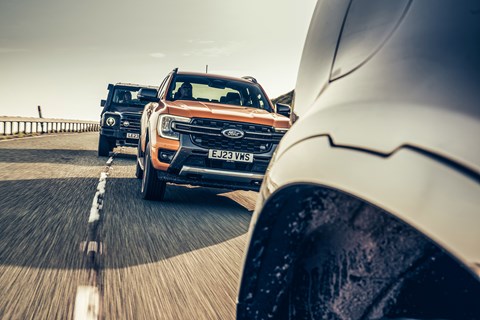
Final reckoning
1st: Land Rover Defender 110
A level of combined road refinement and off-road ability unthinkable just a generation or two ago
★★★★★
2nd: Ineos Grenadier
Huge capability, huge charm and, well, huge. But (lack of) road manners will grate
★★★★★
3rd: Ford Ranger
Outstanding value and superbly capable on-road and off it. Only comes third because something has to
★★★★★
More comparison tests by CAR magazine